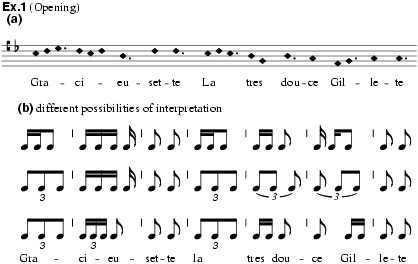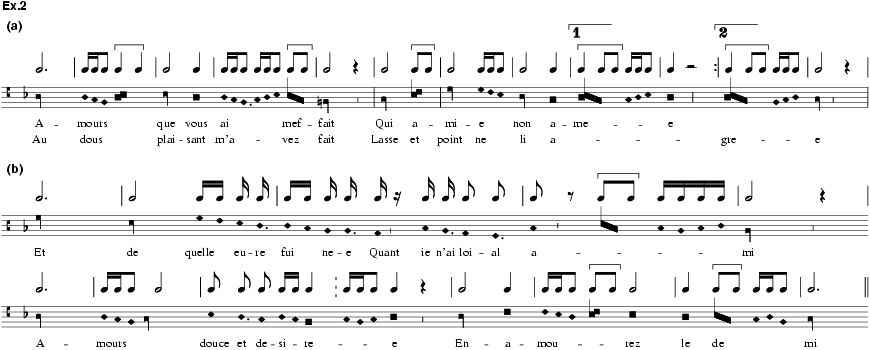
(fl early 14th century). French poet and composer. He is known only from a collection of his works appended to the interpolated version of the Roman de Fauvel (F-Pn fr.146, ff.57r–62v). The transmission and notation of his compositions point to the early 14th century, while references in the text indicate that he worked in Paris. The older identification with a cleric who was hanged in 1304 is not certain; the name is frequently encountered in Paris at that time (Rouse, in Bent and Wathey). The collection contains, after the three-voice rondeau A vous douce debonnaire, 32 monophonic songs and two ‘diz entez’: longer poems whose strophes end with a notated refrain, linked by textual content and rhyme to the preceding strophe. The works are ordered alphabetically and the collection extends to the letter ‘G’; it must therefore constitute only a part of his complete works.
Jehannot's songs form the largest mensurally notated monophonic collection of the period and thus the most important witness to an upheaval in the transition to the new polyphonic ballade and the division into separate genres of the so-called ‘formes fixes’, as they are seen in the mid-14th century in the works of Guillaume de Machaut. The extensive text collection GB-Ob Douce 308 constitutes a counterpart to Jehannot's works; the monophonic French songs in the Roman de Fauvel itself supplement them. In these sources the concept of genre involves a division between the refrain forms ‘rondeau’ and ‘balade’ (or ‘balette’/‘balaite’). The second group encompasses the developing forms of the three-strophe ballade as well as the virelai, but there are overlaps between the two incipient song forms and above all the group encompasses a variety of different structures with individual formal plans and single-strophe formulations.
The content of the texts covers a broad spectrum, from the light tone of the dance-song to the most sophisticated register of grand chant courtois. In the musical formulation, the notational procedures of polyphony, in duple and triple time as well as with semibreve groups divided off by dots, form the basis of a genuinely mensural conception and of a new individualization, the principal characteristic of which is extreme semantic differentiation. Typical of such procedures is the contrast between the light character of the playful Gracieusette, notated in semibreves throughout (see ex.1, with clarification of the different possibilities for rhythmic interpretation), and the long, declamatory note values in the complaint of an ‘amie non amee’ in the emphatic Amours, que vous ai meffait (ex.2a), and also, in the same song, the radical change from long to very short note values at the point where the text speaks of the unfortunate hour that must have led to her unhappiness (ex.2b).


A fundamental feature of melodic formulation lies in the integration of short ornamental groups, such as are seen in variant readings in the upper voices of motets. In the older monophonic song they must have belonged to the realm of performing practice, but they are found in the new song-forms of Machaut and others, where they expand the contrapuntal progressions within the harmonic framework. Reductions of Jehannot's melodies to the level of declamatory rhythmic values of long and breve reveal sequences very similar to those found in older, non-mensural songs (see ex.3, with the beginning of Abundance de felonie in original notation and in reduction, in comparison with the opening of a chanson by Adam de la Halle).

Refrains in the dits, as in the ‘balades’, make use of pre-existing material, with an intertextual link between music and text, even where the material used is obviously new.
Each of these characteristics of Jehannot's monophonic songs recurs in the new polyphonic song style of the later 14th century. By contrast, the three-voice ‘score’-notated rondeau A vous douce debonnaire (of which the middle voice exists, in a different version, as a monophonic work) belongs to the tradition of such works that began with Adam de la Halle; nevertheless, Jehannot's setting contains a strikingly high percentage of imperfect consonances used in a deliberate way.
monophonic unless otherwise stated
Edition: The Works of Jehan de l'Escurel, ed. N. Wilkins, CMM, xxx (1966) [W]
|
Abundance de felonnie, W 7; Amours aus vrais cuers commune, W 2; Amours cent mille merciz, W 4; Amours que vous ai meffait, W 6; Amours trop vous doi cherir, W 8; Amour, voules vous acorder, W 5; Belle com loiaus amans, W 16; Bien se lace, W 10; Bien se peust apercevoir, W 15; Bonne amour me rent, W 12; Bontes, sen, valours et pris, W 11; Comment que pour l'eloignance, W 17; Dame gracieuse et bele, W 23; Dame vo regars m'ont mis en la voie, W 21; D'amour qui n'est bien celee, W 22; De la grant joie d'amours, W 19; Dis tans plus qu'il ne faudroit flours, W 29; Douce Amour confortez moi, W 20; Fi, mesdisans esragie, W 30; Gracieusette, W 32 |
|
A vous douce debonnaire, 3vv, W 1; A vous, douce debonnaire, 1v, W 3; Belle et noble a bonne estrainne, W 14; Bietris est mes delis, W 9; Bonnement m'agree, W 13; Dame, par vo dous regart, W 24; Dame, si vous vient a gre, W 27; De gracieuse dame amer, W 18; Douce dame je vous pri, W 25; Douce desirree, W 26; Diex quant la verrai, W 28; Guilleurs me font mout souvent, W 31 |
|
Gracieuse, faitisse et sage, W 33 |
|
Gracieus temps est quant rosier, W 34 |
F. Gennrich, ed.: Rondeaux, Virelais und Balladen aus dem Ende des XII., dem XIII. und dem ersten Drittel des XIV. Jahrhunderts mit den überlieferten Melodien, i (Dresden, 1927), 307–72 [edn]; ii (Göttingen, 1927), 246 [commentary]
C.V. Langlois: ‘Jean de Lescurel, poète français’, Histoire littéraire de la France, xxxvi (Paris, 1927), 109–15
W. Arlt: ‘Aspekte der Chronologie und des Stilwandels im französischen Lied des 14. Jahrhunderts’, Aktuelle Fragen der musikbezogenen Mittelalterforschung: Basle 1975 [Forum musicologicum, iii (1982)], 193–280, esp. 209–27
L. Earp: ‘Lyrics for Reading and Lyrics for Singing in Late Medieval France: the Development of the Dance Lyric from Adam de la Halle to Guillaume de Machaut’, The Union of Words and Music in Late Medieval Poetry: Austin 1987, 101–31
W. Frobenius: ‘Ballade (Mittelalter)’ (1988), HMT
E.H. Roesner, F. Avril and N.F. Regalado: Le Roman de Fauvel in the Edition of Messire Chaillou de Pesstain (New York, 1990) [facs. with introduction]
S. Asperti: ‘La sezione di balletes del canzionere francese di Oxford’, XXe congrès international de linguistique et philologie romanes: Zürich 1992, ed. G. Hilty (Tübingen, 1993), v, 13–27
R. Mullally: ‘The Ballade before Machaut’, Zeitschrift für französische Sprache und Literatur, civ (1994), 252–68
M. Bent and A. Wathey, eds.: Fauvel Studies: Allegory, Chronicle, Music and Image in Paris, Bibliothèque Nationale de France, MS français 146 (Oxford, 1998) [incl. W. Arlt: ‘Jehannot de Lescurel and the Function of Musical Language in the Roman de Fauvel as Presented in BN fr.146’, 25–34; J.C. Morin: ‘Jehannot de Lescurel's Chansons, Geffroy de Paris's Dits, and the Process of Design in BN fr.146’, 321–36; C. Page: ‘Tradition and Innovation in BN fr.146: the Background to the Ballades’, 353–94; M. and R. Rouse: ‘Jehannot de Lescurel’, 525–7]
WULF ARLT